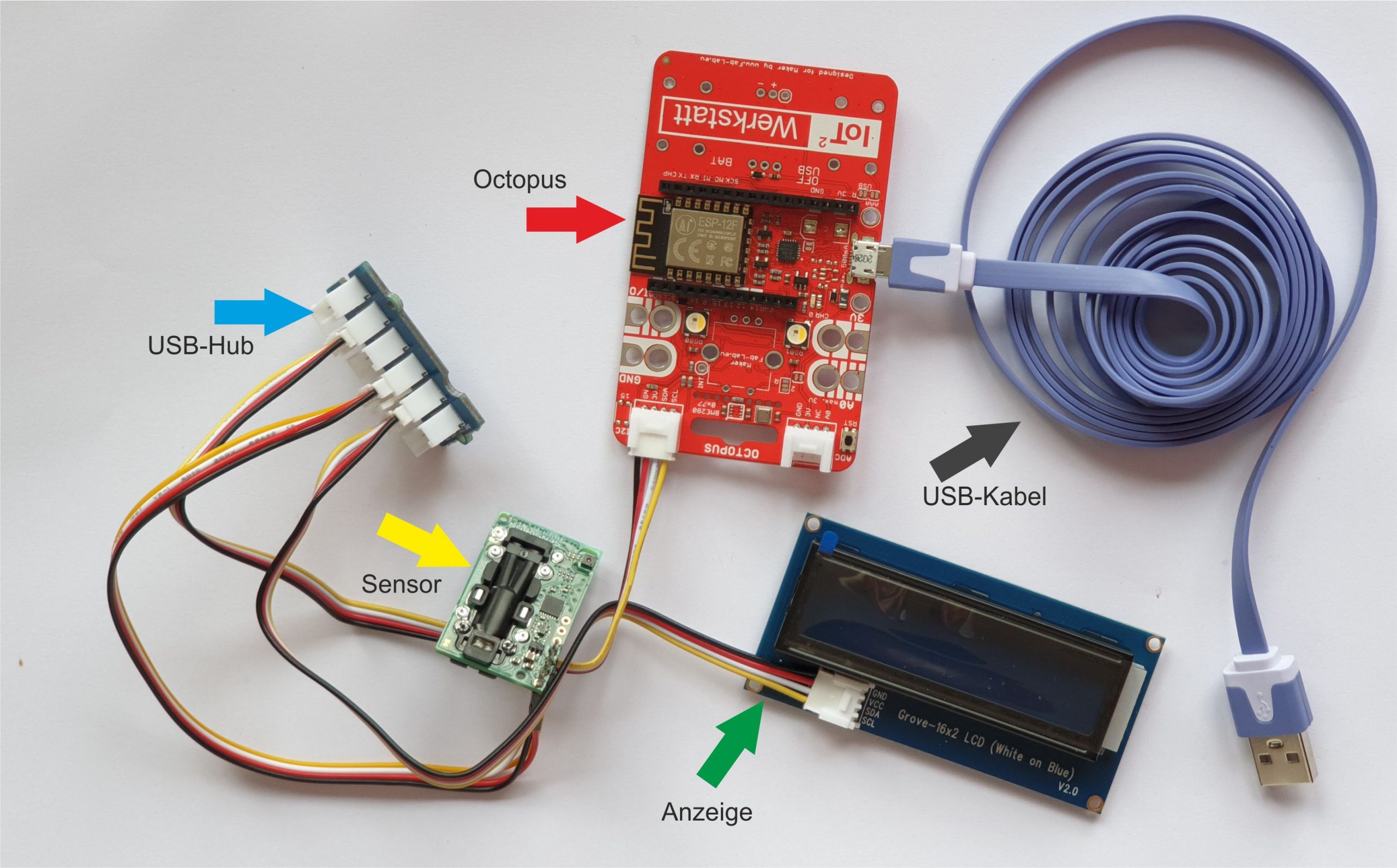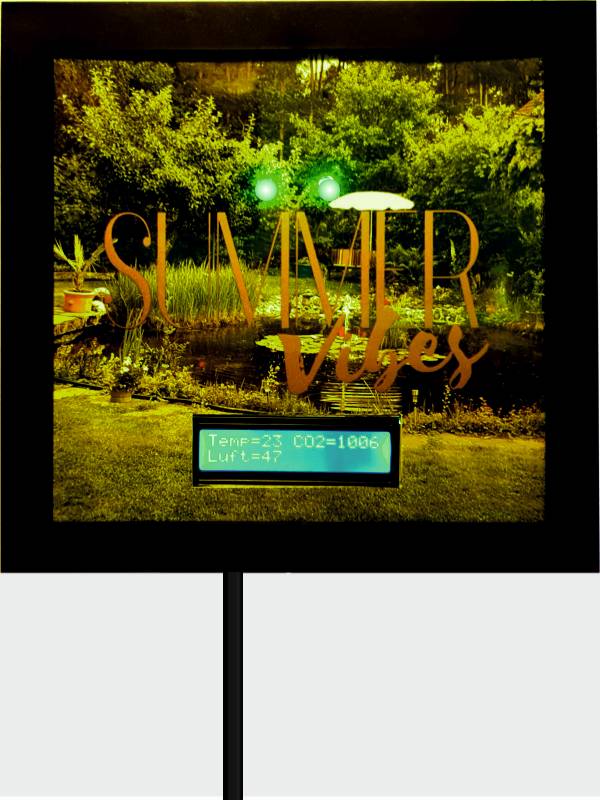4
Johanna Warko
Bevor ich zum Thema CO2-Ampel und Sensoren für Senioren komme, möchte ich dazu eine kleine Geschichte erzählen: Im Meer lebte einst ein Delphin, der mehr wollte als nur herumschwimmen. Er wollte so gern wie ein Vogel fliegen können. Immer wieder rief er den Vögeln zu: Bitte, bringt mir doch das Fliegen bei, ich möchte so gerne auch mal fliegen. Eines Tages hatte ein Vogel Mitleid mit dem armen Delphin und sagte: Warte, ich hole die Eule, die ist weise und hat vielleicht einen guten Rat für dich. Die weise Eule kam angeflogen und der Delphin erzählte ihr: Ich möchte so gerne einmal fliegen, so frei wie die Vögel in der Luft.
Da sagte die Eule zu ihm: Du solltest nicht sagen, du möchtest, du sollst sagen: ICH WILL. Schlage mit deinen Flossen, so gut du kannst, und rufe laut dazu: ICH WILL, ICH WILL! Zunächst dachte der Delphin: Ich mit meinen Flossen schlagen? Das wird doch nie etwas! Aber dann dachte er: Einen Versuch ist es ja wert und schlug so heftig wie möglich mit seinen Flossen und rief ganz laut: ICH WILL, ICH WILL! Und plötzlich erhob er sich und flog und flog und war glücklich wie noch nie in seinem Leben!
Und nun meine eigene ICH WILL Geschichte: Die Teilnehmer am Projekt Sensoren für Senioren sollen in einem Workshop Programmieren lernen und mit dem Wissen anschließend eine CO2-Ampel zum Einsatz bringen können. Na ja, ich und Programmieren! Komplizierte Tastaturbefehle habe ich mir noch nie merken können.
In einem ersten Schritt sollten wir auf einer Platine Neopixel (steuerbare LEDs) zum Leuchten bringen und dazu noch abwechselnd in rot und grün! Ich möchte das natürlich auch können, aber empfinde mich als völlig ungeeignet, bis mir der Spruch der Weisen Eule in den Sinn kommt: ICH WILL!
Das ganze ICH WILL kann allerdings nicht funktionieren ohne ICH WILL LERNEN. Und zwar viel und schnell.
Ich beschäftigte mich also zunächst mit den verwaltungstechnischen Einzelheiten. Ich lernte das Verwaltungstool Trello und die Teamarbeits-Plattform Slack kennen. Beides völlig neu und gewöhnungsbedürftig für mich, aber für die Zusammenarbeit im Team unverzichtbar. Die anschließende Programmierung der Octopus-Gerät war eine Aufgabe, mit der ich viele Wochen beschäftigt war.

So sahen die einzelnen Teile aus, für mich als Laie doch schon sehr beeindruckend. Aber mit Hilfe unserer versierten Mentoren habe ich es dann doch geschafft, nicht nur alles ordentlich zusammen zu stöpseln, sondern auch die beiden LEDs zum Leuchten zu bringen. Das war das Interessante an dieser Aufgabe: Ich sollte die Platine so programmieren, dass die LED grün leuchten, wenn die CO2-Konzentration im Raum niedrig ist; der Wert liegt bei ca. 1.000 ppm. Übersteigt die CO2-Belastung diesen Wert,sollen die LEDs gelb leuchten – das bedeutet: bitte Fenster auf und lüften – aber steigt der Wert über 2.000 ppm, leuchten die LEDs rot und das besagt dann nicht mehr “bitte lüften“, sondern „sofort und unbedingt lüften!”
Das war dann aber noch nicht alles. Eine LCD-Anzeige sollte noch zwei andere Werte sichtbar machen, denn auch Luftfeuchtigkeit und Raumtemperatur sind wichtige Parameter. Die ganze Programmierung stellte sich als richtige Herausforderung heraus (vor allem in Bezug auf logische Folgerungen). Aber ich bin sehr froh, dass ich diese Erfahrung machen durfte. Wohl bedingt durch mein Alter dauerte zwar alles etwas länger und so manches war für mich schon sehr schwer, weil es so viele Themen gab, mit denen ich mich noch nie beschäftigt hatte. Aber am Ende des Workshops war ich doch sehr froh, eine gelungene und funktionierende CO2- Ampel zeigen zu können, sogar mit einem ansprechenden Gehäuse.
CO2-Ampel
Eine interessante Erfahrung war auch, wie Freunde und Bekannte auf meine wochenlangen Bemühungen reagierten. In Erinnerung ist mir zum Beispiel die Entgegnung eines guten Freundes geblieben. Als ich ihm von meinen Fortschritten erzählte und, wie schwer mir doch manches fiel, aber auch wie ich mich freuen konnte, wenn ich wieder eine Hürde genommen hatte, sagte er ganz im Ernst: “Warum tust du dir das an, das ganze Zeug kannst du doch kaufen.”

Das war natürlich für mich das falsche Argument. Denn nun stellt sich heraus, dass ich dieses selbst programmierte Gerät richtig liebgewonnen habe. Zu etwas, was man selber gemacht hat, hat man eindeutig ein anderes Verhältnis. Richtiges Lüften ist zu einem Ritual geworden, ich glaube, soviel tägliche Frischluft hat meine Wohnung noch nie gesehen! Merkwürdigerweise bekomme ich auch ein Gefühl dafür, wann ich mal lüften sollte, sogar bevor das Gerät auf Gelb springt. Auch die anderen Messwerte haben eindeutig ihre Berechtigung.
Fazit: Wer die Möglichkeit bekommt, unter verständnisvoller Anleitung oder/und mit Hilfe aussagekräftiger Videos eine solche CO2-Ampel “zum Leben zu erwecken”, sollte das unbedingt tun, es ist eine sehr wertvolle Erfahrung.
Und so endet meine Geschichte mit der Lehre der Weisen Eule: Mit ICH WILL, ICH WILL habe ich zwar nicht fliegen gelernt, aber dafür eine schöne CO2-Ampel gebastelt und damit bin ich auch sehr zufrieden!
Before I get to the topic of CO2 traffic lights and sensors for seniors, I would like to tell a little story: There was once a dolphin in the sea who wanted to do more than just swim around. He wished very much to be able to fly like a bird. Again and again he shouted to the birds: Please, teach me to fly, I would really would like to fly like you. One day a bird took pity on the poor dolphin and said: Wait, I’ll get the owl, she is wise and may have some good advice for you. The wise owl came over and the dolphin told her: I would like to fly so much, as free as the birds in the air.
The owl told him: You shouldn’t say you would like to fly, you should say: I WANT to fly. Hit your fins as best you can and shout out loud: I WANT, I WANT! At first the dolphin thought: I shall hit my fins? It won’t work! But then he thought: It’s worth a try and hit his fins as hard as possible and called out loudly: I WANT, I WANT! And suddenly he got up and flew and flew and was happier than ever in his life!
And now my own I WANT story: The participants in the sensors for seniors project should learn to program in a workshop and then use the knowledge bring to use a CO2 traffic light. Well, me and coding! I’ve never been able to remember complicated keyboard commands.
In a first step we should light up neopixels (controllable LEDs) on a circuit board and at that alternately in red and green! I would like to be able to do that too, of course, but I feel completely unsuitable until the saying of the wise owl comes to mind: I WANT!
The whole of I WANT, however, cannot function without I WANT TO LEARN. A lot and quickly.
So at first I dealt with the administrative details. I got to know the Trello administration tool and the Slack teamwork platform. Both are completely new and take some getting used to for me, but are indispensable for working together in a team. The subsequent programming of the Octopus device was a task that I was occupied with for many weeks.

This is what the individual parts looked like, very impressive for me as a laywoman. But with the help of our experienced mentors I managed not only to plug everything together properly, but also to light up the two LEDs. That was the interesting thing about this task: I should program the circuit board so that the LED lights up green when the CO2 concentration in the room is low; the value is around 1,000 ppm. If the CO2 load exceeds this value, the LEDs should light up yellow – that means: please open the window and ventilate – but if the value rises above 2,000 ppm, the LEDs light up red and that no longer says “please ventilate”, but rather “ventilate immediately and absolutely!”
But that wasn’t all. An LCD display should make two other values visible, because humidity and room temperature are also important parameters. The whole programming turned out to be a real challenge (especially with regard to logical inferences). But I am very happy that I was able to have this experience. Due to my age, everything took a little longer and some things were very difficult for me because there were so many topics that I had never dealt with before. But at the end of the workshop I was very happy to be able to show a successful and functioning CO2 traffic light, even with an attractive housing.
CO2 traffic light
It was also interesting to see how friends and acquaintances reacted to my weeks of efforts. For example, I remember the reply from a good friend. When I told him about my progress and how difficult some things were for me, but also how happy I was when again I had overcome an obstacle, he said in all seriousness: “Why are you doing this to yourself, You can buy all the stuff.”

Of course, that was the wrong argument for me. Because now it turns out that I have really grown fond of this self-programmed device.You clearly have a different relationship to something you’ve done yourself.Correct ventilation has become a ritual, I think my apartment has never seen so much fresh air every day!Strangely enough, I also get a feeling for the time when ventilation is necessary, even before the device turns yellow.The other measured values are also clearly justified.
Conclusion
If you have the opportunity to “bring to life” such a CO2 traffic light (with understanding guidance and / or with the help of meaningful videos), you should definitely do so, it is a very valuable experience.
And so my story ends with the teaching of the wise owl: I didn’t learn to fly with I WANT, I WANT, but I made a nice CO2 traffic light and I’m very happy with it!
